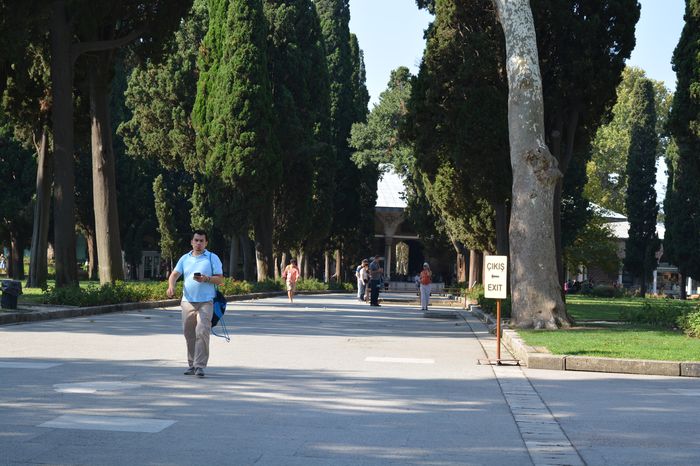The chronicle of Symeon Logothete has been preserved in three forms: an original written to magnify the deeds of Romanos Lekapenos; as the continuation to the Epitome of George the Monk; and as the so-called Chronicle of Pseudo-Symeon.
It is also preserved in a Church Slavonic translation. The work has been preserved in more than 30 separate manuscripts: a large number for a Byzantine text, which suggests that Symeon’s was a very popular history. (The parallel history, known as Theophanes Continuatus, has been preserved in a single manuscript.) The edition in the Bonn corpus (as Georgius Monachus Contiunatus, ed. Bekker, 1842) is attributed to Leo Grammatikos, a scribe known to have been active in 1013.
Symeon’s chronicle covers the period AD 842-948, and consists of three sections which differ in style and perspective. The third section, with which we are concerned, is a description of the period AD 913-48; that is, from the accession of Constantine Porphyrogenitus to the death of Romanos Lekapenos. It must be read alongside book six of Theophanes Continuatus.
Beyond his name, rank and office we know little, with certainty, about the author. Scholarly opinion no longer identifies Symeon the Logothete with Symeon Metaphrastes, although both held the elevated rank of magistros. Alexander Kazhdan (ODB, III, p. 1983) maintained that Metaphrastes, who died c. 1000, was of “the next generation and worked in a different genre”. The Logothete was a more modest author, not versed in the high style Greek employed by Metaphrastes.
His account was written in the sort of language one would associate with a functionary: a “mandarin” style. Its coverage is geographically uneven, focussing on Constantinople at the expense of the provinces. More fundamentally, it presents a eulogized version of the reign of Romanos I Lekapenos. Symeon Logothete, we might conclude, was an official at the court of Romanos Lekapenos, who was commissioned to produce an official history of that emperor’s reign.
However, an alternative identification is possible. James Howard-Johnston has argued convincingly that the core of the Logothete’s account was culled from an earlier hagiographical account of Lekapenos’ reign, which stopped, naturally, with his death. The centrality of Lekapenos to the text, the attention paid to his spiritual development, and the emphasis placed on his charitable deeds and abasement before monks, all suggest that the Logothete had access to a lost biography of the emperor.
Therefore, since it incorporates at least one text completed after 948, the Logothete’s chronicle may have been compiled significantly later than is generally supposed: Howard-Johnston has suggested that it was produced in the 980s, in the context of the struggles between provincial aristocrats and the young ‘Macedonian’ emperor, Basil II. The Logothete’s chronicle, with its provincial style, might then have served as a corrective to the view of recent history promoted by the ‘Macedonian’ dynasty.
I am fortunate to have, in typescript, a full translation by James Howard-Johnston of the final section of the Logothete’s chronicle. I have compared this to my translations of the text of Theophanes Continuatus, which may be accessed below. For these excerpts the preserved texts of Symeon the Logothete and Theophanes Continuatus are all but identical.
THEOPHANES CONTINUATUS
Theophanes Continuatus is the name conventionally applied to a collection of texts preserved in a single eleventh-century manuscript (Vat. gr. 167). It comprises four separate sections covering the period AD 813-961. The first section (813-67) continues Theophanes Confessor, but in a very different style: the anonymous continuator abandons Theophanes strict annalistic format. The second part (867-86) comprises a biography of the emperor Basil I, the so-called Vita Basilii.
The third section (886-948) is very close to Symeon Logothete, and either draws on that work or — if as has been suggested elsewhere, the Logothete’s Chronicle was written later — on the same lost sources, including a hagiographical account of the life and reign of Romanos I Lekapenos. The fourth section (948-61) has been attributed to Theodore Daphnopates, who was the head of the imperial chancery (protasekretis) under Lekapenos, and who before his death (after 961) achieved the rank of magistros.
The first sections of the work were commissioned by the Emperor Constantine VII Porphyrogenitus to present the”‘Macedonian” imperial dynasty in a favourable light. The Vita Basilli eulogizes his grandfather, who founded the Macedonian dynasty, while the section which corresponds to the Logothete’s chronicle has numerous interpolations of a hagiographical nature which enhance the pro-Macedonian aspect.
The sections selected for translation illustrate this perspective, and take as their main focus the fluctuating relationship between Constantine VII, his regents, Romanos Lekapenos, and the ruler of Bulgaria, Symeon (d. 927). Although the Greek is fairly straightforward, I have benefited from access to a partial, handwritten translation of chapters relating to Symeon by Jonathan Shepard.
Read More about The slave sells them or otherwise damages them








